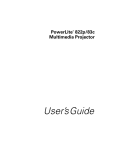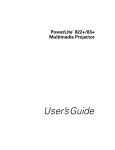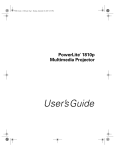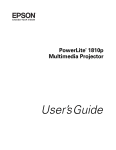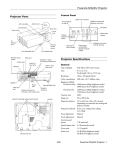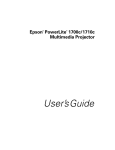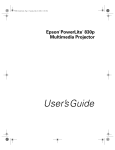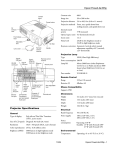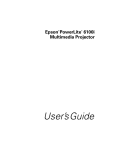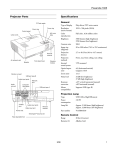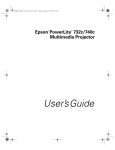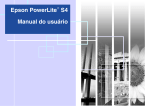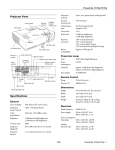Download Epson Projector Lamp
Transcript
PowerLite 822p/83c Multimedia Projector ® User’s Guide Important Safety Information WARNING: Never look into the projector lens when the lamp is turned on; the bright light can damage your eyes. Never let children look into the lens when it is on. Never open any cover on the projector, except the lamp and filter covers. Dangerous electrical voltages inside the projector can severely injure you. Except as specifically explained in this User’s Guide, do not attempt to service this product yourself. Refer all servicing to qualified service personnel. WARNING: The projector and its accessories come packaged in plastic bags. Keep plastic bags away from small children to avoid any risk of suffocation. Caution: When you replace the lamp, never touch the new lamp with your bare hands; the invisible residue left by the oil on your hands may shorten the lamp life. Use a cloth or glove to handle the new lamp. Copyright Notice All rights reserved. No part of this publication may be reproduced, stored in a retrieval system, or transmitted in any form or by any means, electronic, mechanical, photocopying, recording, or otherwise, without the prior written permission of Seiko Epson Corporation. The information contained herein is designed only for use with this Epson product. Epson is not responsible for any use of this information as applied to other products. Neither Seiko Epson Corporation nor its affiliates shall be liable to the purchaser of this product or third parties for damages, losses, costs, or expenses incurred by purchaser or third parties as a result of: accident, misuse, or abuse of this product or unauthorized modifications, repairs, or alterations to this product, or (excluding the U.S.) failure to strictly comply with Seiko Epson Corporation’s operating and maintenance instructions. Seiko Epson Corporation shall not be liable for any damages or problems arising from the use of any options or any consumable products other than those designated as Original Epson Products or Epson Approved Products by Seiko Epson Corporation. Trademarks Epson and Instant Off are registered trademarks, and Epson Exceed Your Vision and Duet are trademarks of Seiko Epson Corporation. PowerLite and PrivateLine are registered trademarks; SizeWise is a trademark; and Epson Store and Extra Care are service marks of Epson America, Inc. Pixelworks, DNX, and the DNX logo are trademarks of Pixelworks, Inc. General Notice: Other product names used herein are for identification purposes only and may be trademarks of their respective owners. Epson disclaims any and all rights in those marks. The contents of this manual are subject to change without notice. © 2007 Epson America, Inc. 2 9/07 Contents Welcome . . . . . . . . . . . . . . . . . . . . . . . . . . . . . . . . . . . . . 7 Getting the Most from Your Projector . . . . . . . . . . . . . . . . . 8 Using Your Documentation . . . . . . . . . . . . . . . . . . . . . . . . . 9 Getting More Information . . . . . . . . . . . . . . . . . . . . . . . 9 Registration and Warranty . . . . . . . . . . . . . . . . . . . . . . . . . 10 Unpacking the Projector. . . . . . . . . . . . . . . . . . . . . . . . . . . 10 Projector Parts . . . . . . . . . . . . . . . . . . . . . . . . . . . . . . . . . . 11 Additional Components . . . . . . . . . . . . . . . . . . . . . . . . . . . 12 Optional Accessories. . . . . . . . . . . . . . . . . . . . . . . . . . . . . . 13 1 Setting Up the Projector . . . . . . . . . . . . . . . . . . . . Positioning the Projector . . . . . . . . . . . . . . . . . . . . . . . . . . Other Installations . . . . . . . . . . . . . . . . . . . . . . . . . . . . Connecting to a Computer. . . . . . . . . . . . . . . . . . . . . . . . . Connecting with the VGA Cable . . . . . . . . . . . . . . . . . Connecting with a VGA-5BNC Cable. . . . . . . . . . . . . Connecting an External Monitor . . . . . . . . . . . . . . . . . Playing Sound Through the Projector . . . . . . . . . . . . . Connecting External Speakers . . . . . . . . . . . . . . . . . . . Connecting to Video Sources . . . . . . . . . . . . . . . . . . . . . . . Connecting a Composite Video Source . . . . . . . . . . . . Connecting an S-Video Source . . . . . . . . . . . . . . . . . . Connecting an RGB Video Source. . . . . . . . . . . . . . . . Connecting a Component Video Source . . . . . . . . . . . Playing Sound Through the Projector . . . . . . . . . . . . . 15 16 17 18 18 20 21 22 23 24 25 26 27 28 29 3 2 Projecting . . . . . . . . . . . . . . . . . . . . . . . . . . . . . . . . . . . . 33 3 Using the Remote Control . . . . . . . . . . . . . . . . . . . 43 4 4 Turning On Your Equipment . . . . . . . . . . . . . . . . . . . . . . . 34 Turning On the Projector . . . . . . . . . . . . . . . . . . . . . . . 34 Selecting the Image Source. . . . . . . . . . . . . . . . . . . . . . . 36 What To Do If You See a Blank Screen . . . . . . . . . . . . . 36 Adjusting the Image . . . . . . . . . . . . . . . . . . . . . . . . . . . . . . . 38 Focusing and Zooming Your Image . . . . . . . . . . . . . . . . 38 Adjusting the Height of Your Image . . . . . . . . . . . . . . . 39 Adjusting the Image Shape. . . . . . . . . . . . . . . . . . . . . . . 40 Adjusting the Brightness . . . . . . . . . . . . . . . . . . . . . . . . 40 Correcting Computer Images. . . . . . . . . . . . . . . . . . . . . 41 Adjusting the Volume . . . . . . . . . . . . . . . . . . . . . . . . . . . . . 41 Shutting Down the Projector . . . . . . . . . . . . . . . . . . . . . . . . 42 Controlling the Picture and Sound. . . . . . . . . . . . . . . . . . . . 44 Switching Between Picture Sources . . . . . . . . . . . . . . . . 44 Adjusting the Color Mode . . . . . . . . . . . . . . . . . . . . . . . 45 Turning Off the Picture and Sound . . . . . . . . . . . . . . . . 46 Stopping Action . . . . . . . . . . . . . . . . . . . . . . . . . . . . . . 46 Zooming Your Image. . . . . . . . . . . . . . . . . . . . . . . . . . . 47 Changing the Image’s Aspect Ratio . . . . . . . . . . . . . . . . 47 Replacing the Batteries . . . . . . . . . . . . . . . . . . . . . . . . . . . . . 48 Fine-tuning the Projector. . . . . . . . . . . . . . . . . . . . 49 Using the Projector’s Menu System . . . . . . . . . . . . . . . . . . . 50 Changing Menu Settings . . . . . . . . . . . . . . . . . . . . . . . . 51 Adjusting Colors and Clarity . . . . . . . . . . . . . . . . . . . . . . . . 52 Adjusting the Input Signal . . . . . . . . . . . . . . . . . . . . . . . . . . 54 Customizing Projector Features . . . . . . . . . . . . . . . . . . . . . . 56 Selecting Projector Setup Options . . . . . . . . . . . . . . . . . . . . 58 Selecting Network Settings . . . . . . . . . . . . . . . . . . . . . . . . . . 60 Viewing Lamp Usage and Other Information. . . . . . . . . . . . 60 Using the Projector’s Security Features. . . . . . . . . . . . . . . . . Creating Your Own Screen Logo. . . . . . . . . . . . . . . . . . Setting a Password . . . . . . . . . . . . . . . . . . . . . . . . . . . . Turning On the Password and User’s Logo . . . . . . . . . . Starting the Projector with a Password. . . . . . . . . . . . . . Disabling the Projector’s Buttons . . . . . . . . . . . . . . . . . Installing Security Locks . . . . . . . . . . . . . . . . . . . . . . . . Restoring the Default Settings . . . . . . . . . . . . . . . . . . . . . . . 62 63 64 65 66 67 67 68 5 Maintenance and Transportation .......... Cleaning the Lens . . . . . . . . . . . . . . . . . . . . . . . . . . . . . . . . Cleaning the Projector Case . . . . . . . . . . . . . . . . . . . . . . . . . Cleaning and Replacing the Air Filter . . . . . . . . . . . . . . . . . Replacing the Lamp . . . . . . . . . . . . . . . . . . . . . . . . . . . . . . . Resetting the Lamp Timer . . . . . . . . . . . . . . . . . . . . . . . . . . Transporting the Projector. . . . . . . . . . . . . . . . . . . . . . . . . . 69 70 70 70 72 75 76 6 Solving Problems . . . . . . . . . . . . . . . . . . . . . . . . . . . . Using On-Screen Help. . . . . . . . . . . . . . . . . . . . . . . . . . . . . What To Do When the Lights Flash . . . . . . . . . . . . . . . . . . Solving Problems with the Image or Sound . . . . . . . . . . . . . Solving Password Problems . . . . . . . . . . . . . . . . . . . . . . . . . Solving Problems with the Remote Control . . . . . . . . . . . . . Solving Network Problems. . . . . . . . . . . . . . . . . . . . . . . . . . Where To Get Help. . . . . . . . . . . . . . . . . . . . . . . . . . . . . . . Speak to a Support Representative. . . . . . . . . . . . . . . . . 77 78 78 80 85 86 87 87 88 7 Monitoring the Projector Over a Network . . 89 Installing the Network Software. . . . . . . . . . . . . . . . . . . . . . Windows System Requirements . . . . . . . . . . . . . . . . . . Installing the Software on a Windows System . . . . . . . . Connecting to the Network . . . . . . . . . . . . . . . . . . . . . . . . . Selecting Network Settings. . . . . . . . . . . . . . . . . . . . . . . . . . Using Projector E-mail Alerts . . . . . . . . . . . . . . . . . . . . 90 90 90 91 92 93 5 Using EMP Monitor . . . . . . . . . . . . . . . . . . . . . . . . . . . . . . 94 Opening and Closing EMP Monitor . . . . . . . . . . . . . . . 94 Registering a Projector . . . . . . . . . . . . . . . . . . . . . . . . . . 95 Monitoring Your Projector . . . . . . . . . . . . . . . . . . . . . . 95 Using E-mail Alerts . . . . . . . . . . . . . . . . . . . . . . . . . . . . 98 Using a Browser to Monitor the Projector . . . . . . . . . . . . . . 99 A Technical Specifications . . . . . . . . . . . . . . . . . . . . 101 B Notices . . . . . . . . . . . . . . . . . . . . . . . . . . . . . . . . . . . . . . 109 General. . . . . . . . . . . . . . . . . . . . . . . . . . . . . . . . . . . . . . . . 101 Projection Lamp. . . . . . . . . . . . . . . . . . . . . . . . . . . . . . . . . 102 Remote Control . . . . . . . . . . . . . . . . . . . . . . . . . . . . . . . . . 102 Dimensions . . . . . . . . . . . . . . . . . . . . . . . . . . . . . . . . . . . . 102 Electrical . . . . . . . . . . . . . . . . . . . . . . . . . . . . . . . . . . . . . . 102 Environmental . . . . . . . . . . . . . . . . . . . . . . . . . . . . . . . . . . 103 Safety and Approvals . . . . . . . . . . . . . . . . . . . . . . . . . . . . . 103 Compatible Video Formats . . . . . . . . . . . . . . . . . . . . . . . . 104 Compatible Computer Display Formats. . . . . . . . . . . . . . . 105 Important Safety Instructions . . . . . . . . . . . . . . . . . . . . . . . 109 FCC Compliance Statement. . . . . . . . . . . . . . . . . . . . . . . . 111 Index . . . . . . . . . . . . . . . . . . . . . . . . . . . . . . . . . . . . . . . . 113 6 - Welcome The PowerLite ® 822p/83c is a portable projector that weighs less than 7 pounds. The projector offers 2600 ANSI lumens (822p) or 2200 ANSI lumens (83c) of brightness. From classrooms to boardrooms, your full-color presentations and videos will be bright and vibrant even in ordinary indoor lighting. Images are displayed at a native resolution of 1024 × 768 pixels. Epson® 3LCD technology ensures accurate color and remarkable saturation, even in well-lit rooms. You can connect the projector to a wide range of computers, including IBM®-compatible PCs and laptops, Apple® Macintosh,® PowerPC® and Intel® Core™ Macintosh computers, PowerBook®computers, and many iMac® and iBook® series systems. With Epson’s patented SizeWise™ technology, the projector supports computer displays ranging from VGA through UXGA. You can use any of the following video sources: HDTV, VCR, DVD player, gaming console (such as Microsoft® Xbox,™ Sony® PlayStation® 3, and Nintendo Wii™), camcorder, or digital camera. The projector supports NTSC, PAL, and SECAM video formats. You can also connect the projector to a LAN (local area network) so you can monitor the projector from a remote network computer using the included EMP Monitor software. You can connect up to four devices to the projector at the same time. With the projector’s Source Search button, you don’t even have to identify your input source. Just press the button until you see the image you want on the screen. 7 To prevent unauthorized use of the projector, you can assign a password, create a user logo which is displayed at startup to identify the projector, and disable the projector’s buttons through a full or partial Operation Lock feature. For more information about security features, see page 62. Getting the Most from Your Projector Depending on your presentation, you can take advantage of any or all of these options: ■ Connecting to a laptop or other computer If you want to connect the projector to a laptop or desktop computer, see page 18. For additional presentation control, you can connect an external monitor to view the presentation on your computer simultaneously. ■ Connecting to video sources You can connect a DVD player, VCR, HDTV, camcorder, digital camera, and other video sources to your projector. See page 24 for instructions. ■ Using the remote control The remote control lets you switch from computer to video sources, zoom in on part of your image, freeze or mute the presentation, and adjust many other projector features. For details, see Chapter 3. ■ Enhancing sound in your presentation By connecting your projector to external speakers, you can enhance the audio impact of your presentations. 8 Welcome Using Your Documentation In addition to this manual, your documentation includes a Quick Setup sheet, warranty brochures, and an Epson PrivateLine® Support card. The Quick Setup sheet gives instructions to quickly set up your projector and connect it to a computer or video device. note The instructions here apply to the PowerLite 822p and PowerLite 83c projectors and cover both projectors, unless noted. This book contains all the information you need to set up and use your projector. Please follow these guidelines as you read through it: ■ Warnings must be followed carefully to avoid bodily injury. ■ Cautions must be observed to avoid damage to your equipment. ■ Notes contain important information about your projector. Getting More Information Need tips on giving presentations? How about quick steps for setting up your projector? Here’s where you can look for help: ■ www.presentersonline.com Includes a library of articles covering presentation tips, tricks, and technology. The site provides templates, clip art, and sound clips, as well as Presenters Services to use on the road. Even more resources and services are available if you register to join the Presenters Club—and it’s free. ■ Built-in help system Press the Help button on the remote control or projector to get quick solutions for common problems. See page 78 for details. ■ epson.com/support Download FAQs (frequently asked questions) and e-mail your questions to Epson support on the PowerLite 822p or PowerLite 83c. If you still need help after checking this User’s Guide and the sources listed above, you can use the Epson PrivateLine Support service to get help fast. Call (800) 637-7661 and enter the PIN on your PrivateLine Support card. See page 87 for more information. Welcome 9 Registration and Warranty Your projector comes with a basic carry-in warranty and an international warranty that let you project with confidence anywhere in the world. For details, see the warranty brochures that came with your projector. In addition, Epson offers Extra CareSM Road Service at no additional charge. In the unlikely event of an equipment failure, you won’t have to wait for your unit to be repaired. Instead, Epson will ship you a replacement unit anywhere in the United States or Canada, usually within one business day. See the Extra Care Road Service brochure for details. To register, complete the registration form that came with your projector and mail it to Epson. Or register your product online using your projector CD, or at: http://www.epson.com/webreg Registering also lets you receive special updates on new accessories, products, and services. Unpacking the Projector After unpacking the projector, make sure you have all these items: Projector Remote control and batteries Password Protected Sticker VGA computer cable Power cord Save all packaging in case you need to ship the projector. Always use the original packaging (or equivalent) when you send the projector to another location. See page 76 for transportation instructions. 10 Welcome Projector Parts Front Security slot Control panel A/V mute slide lever Lamp cover Zoom ring Focus ring Air exhaust vent A/V mute slide Front adjustable foot Foot release lever Back S-Video port LAN port Video port Remote control sensor Audio L-R input ports Computer 1 and 2 (Component Video) ports Audio 1 and 2 input ports Remote control sensor Speaker Audio Out port Monitor Out port (for Computer1 port output only) Power inlet RS-232C serial port Rear adjustable foot Bottom Air filter Holes for ceiling mount bracket Hole for ceiling mount bracket Security lock slot Welcome 11 Control Panel Turns projector on and off Opens menu system Up/down arrows and keystone correction Cancel/exit Opens help system Indicate projector status Searches for source image Left/right arrows and Volume down/up Automatically adjusts computer images Additional Components Depending on how you plan to use the projector, you may need additional components: 12 Welcome ■ To receive an S-Video signal, you need an S-Video cable. One is usually provided with your video device or you can purchase it from Epson. See page 13. ■ To receive a component video signal from a VCR or other video device, you need a D-sub, 15-pin, component-to-VGA video cable, which is available from Epson. See page 13. ■ Some older PowerBooks and Macintosh desktop models may need a Macintosh video adapter; see your computer dealer. Older iMac systems may need a special adapter to provide a VGA output port; see your computer dealer. ■ To receive an audio signal, you need a commercially available audio cable; see your computer or electronics dealer. Optional Accessories note To enhance your use of the projector, Epson provides the following optional accessories: Product Product number Replacement lamp VI3H010L42 Air filter set (includes 2 filters) V13H134A13 Component-to-VGA video cable S-Video cable ELPKC19 ELPSV01 Distribution amplifier ELPDA01 50-inch portable screen (4:3 aspect ratio) 60-inch portable pop-up screen (4:3 aspect ratio) 80-inch portable pop-up screen (4:3 aspect ratio) 83.6-inch hanging pull-down screen (4:3 aspect ratio) Duet™ Ultra Portable Projector screen (4:3 and 16:9 aspect ratio) ELPSC06 ELPSC07 ELPSC08 ELPSC09 ELPDC05 high resolution document imager V12H162020 Kensington® ELPSL01 security lock Ceiling mount (gyro lock with suspension adapter) False ceiling plate Suspension adapter Security bracket/cabling for gyro lock mounts Adjustable ceiling channel To purchase a replacement remote control, call (562) 276-4394 (U.S.) or (905) 709-3839 (for dealer referral in Canada). ELPSC80 ELPMBUNI ELPMBFCP ELPMBAPL ELPMBSEC ELPMBACC You can purchase screens, carrying cases, or other accessories from an Epson authorized reseller. To find the nearest reseller, call 800-GO-EPSON (800-463-7766). Or you can purchase online at www.epsonstore.com (U.S. sales) or www.epson.ca (Canadian sales). Welcome 13 14 Welcome 1 Setting Up the Projector T his chapter tells you how to set up the projector and connect it to a computer or video source. You can connect up to four devices simultaneously: four video sources, or two computer and two video sources. You’ll find instructions for the following in this chapter: ■ Positioning the projector ■ Connecting to a computer ■ Connecting to video sources 15 Positioning the Projector Before connecting the projector, you need to decide where to place it. If you’re setting up the projector yourself and it isn’t already installed in the room you’re using, you’ll probably want to place it on a table in front of the screen, as shown. note You can download the Projection Distance Calculator program from the Drivers and Downloads section of Epson’s web site: www.epson.com/support This lets you stand in the front of the room, face the audience, and remain close enough to the equipment to be able to control it. Try to leave as much space as possible between the projector and the screen to get a good-size image. Place the projector somewhere between 3 and 30 feet from the screen. Use the figure below to help you determine exactly how far. Image size increases with distance, but can vary depending on how you’ve adjusted the optical zoom and other settings. 28 to 34 ft (4:3) 31 ft (16:9; wide only) 5.6 to 6.8 ft (4:3) 6.1 to 7.3 ft (16:9) 2.7 to 3 ft (4:3) 3 to 3.6 ft (16:9) Also keep these considerations in mind: 16 Setting Up the Projector ■ Place the projector on a sturdy, level surface. ■ Make sure there is plenty of space for ventilation around and under the projector. Do not set the projector on top of loose papers that could block the vents under the projector. ■ Make sure the projector is within 6 feet (2 meters) of a grounded electrical outlet or extension cord. Try to place the projector directly in front of the center of the screen, facing it toward the screen squarely. If the projector isn’t positioned this way, the image will be “keystone” shaped, instead of square or rectangular. If you place the projector below the level of the screen, you’ll have to tilt it up by extending the front adjustable foot, as described on page 39. This also causes the image to lose its rectangular shape. You can adjust the shape using the buttons on the projector (see page 40), or using the projector’s menu system (see page 49). The Auto Keystone feature corrects the distortion automatically. See page 57 for more information about Auto Keystone correction. If necessary, you can adjust the image shape manually as described on page 40. Other Installations You can also project from behind the screen or from the ceiling, with the projector mounted upside-down: Rear projection (using a translucent screen) Front/ceiling projection Rear/ceiling projection (using a translucent screen) To project from overhead, you’ll need the optional ceiling mount hardware. (See page 13 for ordering information.) You’ll also need to select Front/Ceiling or Rear/Ceiling for the Projection option in the Extended menu. To project from the rear, select Rear. See page 58 for more information. Setting Up the Projector 17 Connecting to a Computer note If you have an iBook with an RCA video-out port, follow the instructions for connecting to a video device on page 25. You can connect the projector to any computer that has a standard VGA or BNC monitor port, including PC notebook and laptop computers, Macintosh PowerBooks and iBooks, and hand-held devices. Follow the instructions in this section to: ■ Connect the projector to your computer with the VGA cable included with the projector. ■ Connect the projector to your computer with a commercially available VGA–5BNC cable. After connecting the projector to your computer, you may also want to: ■ Connect a monitor to the projector so you can view your presentation close-up as well as on-screen (not necessary if you’re using a laptop); see page 21. ■ Connect the projector to your computer with a commercially available audio cable to play computer audio; see page 22. Connecting with the VGA Cable Follow these instructions to connect to your computer with the VGA cable that came with your projector. Before you start, make sure your computer and the projector are turned off. 1. If you are connecting the projector to a desktop computer, disconnect the monitor cable from your computer. 2. Locate the VGA computer cable that came with the projector. VGA computer cable 18 Setting Up the Projector Connect one end of the cable to the projector’s Computer1 or Computer2 port. Computer1 and Computer2 ports 3. Connect the other end of the cable to your computer’s video-out or monitor port. If you’re using a PowerBook or iBook and you can’t connect the cable, you may need to use an optional Macintosh video adapter; see your computer dealer. 4. If you connected the computer to the Computer1 port and you want to view the display simultaneously on your computer monitor and the projector screen, see “Connecting an External Monitor” on page 21. 5. To play audio from your computer through the projector speakers, see “Playing Sound Through the Projector” on page 22. 6. Tighten the screws on the connectors. If you don’t need to make any other connections, you can plug in your projector and turn it on. See page 34 for instructions. If more than one device is connected to the projector, select the correct source after projection starts by pressing the Source Search button on the projector or remote control. See page 36. Setting Up the Projector 19 Connecting with a VGA-5BNC Cable VGA-5BNC cable If your computer provides video output through BNC connectors, follow these instructions to connect the projector to your computer with an optional VGA-5BNC cable. Before you start, make sure your computer and the projector are turned off. 1. Disconnect the monitor cable from your computer. 2. Connect the cable’s VGA connector to the projector’s Computer1 or Computer2 port. Computer1 and Computer2 ports 3. Connect the BNC connectors to your computer’s BNC ports. 4. If you want to view the display simultaneously on your computer monitor and the projector screen, see “Connecting an External Monitor” on page 21. 5. To play audio from your computer through the projector speakers, see “Playing Sound Through the Projector” on page 22. 6. Tighten the screws on the VGA connector. If you don’t need to make any other connections, you can plug in your projector and turn it on. See page 34 for instructions. If more than one device is connected to the projector, select the correct source after projection starts by pressing the Source Search button on the projector or remote control. See page 36. 20 Setting Up the Projector Connecting an External Monitor If you want to see your presentation close-up as well as on the projection screen, you can connect an external monitor to the projector. This lets you view images on your computer monitor while the projector is in standby mode (plugged in but not turned on) and check your presentation or switch between picture sources even if you’ve pressed the A/V Mute button on the remote control to turn off projection on the screen. Simultaneous display is possible only when the computer is connected to the projector’s Computer1 port. Make sure the projector and computer are off. Then connect the monitor’s cable to the projector’s Monitor Out port, as shown: note Some LCD monitors may not be able to display the image correctly. If you have trouble displaying the image, connect a multiscan monitor. If you’re projecting computer images, make sure the computer’s refresh rate is set to 65 Hz or greater. If you don’t need to make any other connections, you can plug in your projector and turn it on. See page 34 for instructions. Setting Up the Projector 21 Playing Sound Through the Projector You can connect a commercially available 3.5 mm stereo mini-jack audio cable to take advantage of the projector’s built-in speaker. You can obtain the audio cable from a computer or electronics dealer. 1. Connect one end of the 3.5 mm stereo mini-jack audio cable to the corresponding Audio1 or Audio2 jack on the projector. Audio1 and Audio2 jacks 2. Connect the other end of the audio cable to your laptop’s headphone jack or audio-out jack, or your desktop’s speaker or audio-out port. If you don’t need to make any other connections, you can plug in your projector and turn it on. See page 34 for instructions. 22 Setting Up the Projector Connecting External Speakers You can output sound to external speakers with built-in amplifiers. When you play sound through external speakers, the projector’s built-in speaker system is disabled. 1. Locate the appropriate cable to connect your speakers. Depending on your speakers, you may be able to use a commercially available audio cable with a stereo mini-jack connector on one end and pin jacks on the other end. For some speakers, you may have to purchase a special cable or use an adapter. 2. Connect the stereo mini-jack end of the audio cable to the Audio Out port on the projector. 3. Connect the other end of the cable to your speakers. The projector’s internal speaker system is disabled while sound is output to external speakers, and you can’t use the projector or remote control to adjust the volume. Setting Up the Projector 23 Connecting to Video Sources You can connect a DVD player, VCR, camcorder, digital camera, gaming console, or any other compatible video source to your projector. You can connect up to four video devices at one time. note The projector does not support TV antenna cable F connectors. The projector supports HDTV, SDTV, NTSC, PAL, and SECAM, and automatically detects the video format. It can receive composite video, S-Video, RGB video, and component video. The type of cable you need depends on the video source: ■ For composite video, use a commercially available RCA A/V cable. See page 25. ■ For S-Video, use the S-Video cable supplied with your video device or order one from Epson. See page 26. ■ For RGB video, use the VGA computer cable included with the projector. See page 27. ■ For component video, you’ll need the optional Epson component-to-VGA video cable. See page 28. After connecting your video device to the projector, you may want to connect an audio cable to play sound from your video equipment through the projector’s built-in speaker or external speakers. See page 29 for instructions. 24 Setting Up the Projector Connecting a Composite Video Source If you’re connecting a composite video device, use a commercially available RCA A/V cable. Before starting, make sure the projector and your DVD player or other video source are turned off. 1. Connect the yellow RCA plug on one end of the cable to the projector’s yellow Video port. Video port 2. Connect the yellow plug on the other end of the cable to the video-out port on your video source. 3. To play sound through the projector, follow the instructions beginning on page 29. If you don’t need to make any other connections, you can plug in your projector and turn it on. See page 34 for instructions. If more than one device is connected to the projector, select the correct source after projection starts by pressing the Source Search button on the projector or remote control. See page 36. Setting Up the Projector 25 Connecting an S-Video Source If your video source has an S-Video jack, you can use it to project a higher quality video image. You’ll need an S-Video cable, which is usually provided with your video source, or you can purchase one from Epson (part number ELPSV01). See page 13 for ordering information. Before starting, make sure the projector and your DVD player or other video source are turned off. 1. Insert one end of the S-Video cable into the projector’s S-Video port and the other end into the S-Video output port of your video source. S-Video port 2. To play sound through the projector, follow the instructions beginning on page 29. If you don’t need to make any other connections, you can plug in your projector and turn it on. See page 34 for instructions. If more than one device is connected to the projector, select the correct source after projection starts by pressing the Source Search button on the projector or remote control. See page 36. 26 Setting Up the Projector Connecting an RGB Video Source Follow these instructions to connect the projector to a video player or satellite receiver that has an RGB video output port using the VGA computer cable that came with the projector. Before starting, make sure the projector and your DVD player or other video source are turned off. 1. Connect one end of the VGA computer cable to the Computer1 or Computer2 port on the projector. Computer1 and Computer2 ports 2. Connect the other end to the video port on your player. 3. To play sound through the projector, follow the instructions beginning on page 29. If you don’t need to make any other connections, you can plug in your projector and turn it on. See page 34 for instructions. If more than one device is connected to the projector, select Computer 1 or Computer 2 as the source after projection starts by pressing the Source Search button on the projector or remote control. See page 36. Setting Up the Projector 27 Connecting a Component Video Source If your video source has component video connectors, you can use them to project a higher quality video image. You’ll need a component-to-VGA video cable, which can be purchased from Epson (part number ELPKC19). See page 13 for ordering information. Before starting, make sure the projector and your DVD player or other video device are turned off. 1. Connect the 15-pin VGA connector end of the component-to-VGA video cable to the projector’s Computer1 or Computer2 port. Computer1 and Computer2 ports 2. Insert the three component ends of the component-to-VGA video cable into the color-coded video output ports on your video source, usually labelled Y, Pb, Pr or Y, Cb, Cr. 3. To play sound through the projector, follow the instructions beginning on page 29. If you don’t need to make any other connections, you can plug in your projector and turn it on. See page 34 for instructions. If more than one device is connected to your projector, select Computer1 or Computer2 as the source by pressing the Source Search button on the projector or the remote control. See page 36. 28 Setting Up the Projector Playing Sound Through the Projector The projector has a built-in speaker with a maximum output of 7 W. You can play sound from your video equipment through the projector’s speaker if your video device has an audio output port. For RCA-Type Audio Output Ports Most video devices have an RCA-type audio output port. In this case, use a commercially available RCA-type audio cable to connect the projector to your video source: 1. Connect one end of the RCA audio cable to the L-Audio-R jacks on the projector. L-Audio-R jacks 2. Connect the red and white plugs on the other end of the RCA audio cable to the corresponding color-coded audio output port on your video source. If you don’t need to make any other connections, you can plug in your projector and turn it on. See page 34 for instructions. Setting Up the Projector 29 For Stereo Mini-Jack Audio Output Ports Some video devices, especially camcorders, may have a stereo mini-jack audio output port. To connect to the L-Audio-R input jacks when using the S-Video or Video port, use a commercially available stereo mini-jack audio adapter cable (3.5-mm stereo miniplug to two male RCA plugs) to connect to the projector. 1. Connect one end of the audio adapter cable to the L-Audio-R jacks on the projector. L-Audio-R jacks 2. Connect the other end of the audio adapter cable to your video device’s audio output port. If you don’t need to make any other connections, you can plug in your projector and turn it on. See page 34 for instructions. 30 Setting Up the Projector Connecting External Speakers You can output sound to external speakers with built-in amplifiers. When you play sound through external speakers, the projector’s built-in speaker system is disabled. 1. Locate the appropriate cable to connect your speakers. Depending on your speakers, you may be able to use a commercially available audio cable with a stereo mini-jack connector on one end and pin jacks on the other end. For some speakers, you may have to purchase a special cable or use an adapter. 2. Connect the stereo mini-jack end of the audio cable to the Audio Out port on the projector. 3. Connect the other end of the cable to your speakers. The projector’s internal speaker system is disabled while sound is output to external speakers, and you can’t use the projector or remote control to adjust the volume. Setting Up the Projector 31 32 Setting Up the Projector 2 Projecting Once you’ve set up the projector, you’re ready to turn it on, adjust the image, and give your presentation. Although you can operate the projector without it, the remote control lets you use additional features. See Chapter 3 for instructions on using the remote. This chapter covers the following: ■ Turning on the projector and other equipment ■ Adjusting the image ■ Adjusting the volume ■ Shutting down the projector 33 Turning On Your Equipment Make sure your projector and other equipment are set up and connected correctly, as described in Chapter 1. Then turn on your projector, as described below. If you turn on your connected computer or video equipment before starting the projector, the projector automatically detects and displays the image source. If you turn on the projector first, or have multiple pieces of connected equipment, you may have to select the image source manually. See page 36. Turning On the Projector Follow these steps to plug in and turn on the projector: 1. Open the A/V Mute slide (lens cover). 2. Connect one end of the power cord to the projector’s power inlet. 34 Projecting 3. Connect the other end to an electrical outlet. The P Power light on top of the projector turns orange, indicating that the projector is receiving power but not yet turned on. 4. Turn on your computer or video source if you have not already. 5. Press the P Power button on the projector or on the remote control to turn it on. note If you are using the remote control for the first time, be sure to insert the batteries as described on the Quick Setup poster. Power button The projector beeps and the P Power light flashes green as the projector warms up. The projector lamp comes on in about 5 seconds and the P Power light stays green. ■ If you’re using a computer, you should see your computer display projected after a moment or two. If not, you need to select the image source. See page 36. warning Never look into the lens when the lamp is on. This can damage your eyes, and is especially dangerous for children. (With Windows, if you see a message saying that it has found a plug-and-play monitor, click Cancel.) ■ If you’re projecting a video, you may need to press the Source Search button on the projector or remote control to switch to your video source. Then press the Play button on your DVD player or other device. ■ If you are prompted to enter a password, see page 66. To focus and adjust the image, see page 38. If a projected image fails to appear, see “What To Do If You See a Blank Screen” on page 36. When you’re done, shut down the projector as described on page 42. Projecting 35 Selecting the Image Source note The name of the selected image source appears briefly in the upper right corner of the screen. Selecting the image source lets you switch between images input from different pieces of equipment connected to the projector (such as a computer and DVD player). If you don’t see the image you want, press the Source Search button on the remote control or projector until the correct device image is projected. If a projected image fails to appear, see the next section for help. Once you see your image, turn to page 38 for instructions on focusing and making other image adjustments. What To Do If You See a Blank Screen If you see a blank screen or a blue screen with the message No Signal after turning on your computer or video source, try the following: ■ Make sure the cables are connected correctly, as described in Chapter 1. ■ Make sure the P Power light is green and not flashing and the A/V Mute slide is open. ■ Make sure you’ve selected the correct image source; see the previous section. Allow a few seconds for the projector to sync up after pressing the button. ■ Check the Signal menu to make sure the correct input source is selected. See page 54. If you’re using a PC laptop: ■ Hold down the Fn key and press the function key that lets you display on an external monitor. It may have an icon such as or it may be labelled CRT/LCD. Allow a few seconds for the projector to sync up after pressing it. Check your laptop’s manual or online help for details. On most systems, the or CRT/LCD key lets you toggle between the LCD screen and the projector, or display on both at the same time. 36 Projecting ■ If you’re projecting from a laptop, and you don’t see the same image on the projection screen and computer screen, check your monitor settings to make sure both the LCD screen and the external monitor port are enabled. From the Control Panel, open the Display utility. Click the Settings tab, then click Advanced. The method for adjusting the settings varies by brand; you may need to click a Monitor tab, then make sure the external Monitor port is set as your primary display and/or enabled. See your computer’s documentation or online help for details. If you’re using a Macintosh laptop with OS X: You may need to set up your system to display on the projector screen as well as the LCD screen. Follow these steps: 1. From the Apple menu, select System Preferences, then click Display or Displays. 2. Select VGA Display or Color LCD, click Arrange or Arrangement, and make sure Mirror Displays is checked. Click here Select Mirror Displays Projecting 37 Adjusting the Image Once you see your image, you’ll need to make certain adjustments: ■ To focus or zoom your image, see below. ■ If the image is too high or too low, you can reposition it. See page 39. ■ If the image isn’t square, see page 40. ■ To adjust image brightness, see page 40. ■ If a computer image displays incorrectly, see page 41. You can make many other adjustments to the image—such as changing the brightness, contrast, and aspect ratio—using the projector’s menu system. See Chapter 4 for more information. Focusing and Zooming Your Image Rotate the focus ring to sharpen the image, and the zoom ring to reduce or enlarge the image. Focus Zoom You can also change the image size by moving the projector closer to or farther away from the screen. You can use the E-Zoom buttons on the remote control to zoom in on a portion of the image. See page 47 for instructions. 38 Projecting Adjusting the Height of Your Image If the image is too high or low, you can correct it by adjusting the projector’s front foot. 1. Stand behind the projector. Press up on the blue foot release lever and lift the front of the projector to extend the front adjustable foot. 2. Once the image is positioned where you want, release the lever to lock the foot in position. The projector automatically corrects images that are distorted when the projector is tilted up or down (up to a 30° tilt). The Keystone window appears on the screen while the projector makes the correction. If the projected image still isn’t rectangular, follow the instructions in the next section. Projecting 39 Adjusting the Image Shape If the projector is tilted up or down, the images that are displayed will be distorted. To correct the distortion or “keystone” shape, do one or more of the following: ■ If your image looks like or , you’ve placed the projector off to one side of the screen, at an angle. Move it directly in front of the center of the screen, facing the screen squarely. ■ If your image looks like or , you need to adjust the keystone correction value. Press the or buttons on the projector to correct the shape of the image. After correction, your image will be slightly smaller. ■ You may need to turn on Auto Keystone. See page 56 for instructions. You can also make keystone adjustments using the projector’s Settings menu. See page 56. Adjusting the Brightness The brightness of an image depends on the source you are projecting and the amount of light in the room. If the image is too bright or not bright enough, here are two ways you can adjust it: 40 Projecting ■ Change the Brightness setting in the Image menu. See page 53. ■ Select Low or High for the Brightness Control option in the Settings menu. (See page 57.) Low brightness mode extends the life of the lamp and decreases the fan noise. Correcting Computer Images If you’ve connected a computer and the image doesn’t look right, or it doesn’t fit properly on the screen, press the Enter button on the projector or the Enter/Auto button on the remote control. This automatically resets the projector’s tracking, sync, resolution, and position settings. You must be projecting a computer image for this button to have any effect. Additionally, if the Auto Setup option in the Signal menu is set to Off, the Auto function will not work. See page 55. Adjusting the Volume You can use the Vol- and Vol+ buttons on the remote control to increase or decrease the volume for the projector’s built-in speaker. You can also use the buttons on the projector to control the volume. Press the button to increase the volume, or the button to decrease it. A volume gauge appears on the screen while the volume is being adjusted. note You can also adjust the volume using the projector’s Settings menu. See page 56 for details. You must adjust the volume separately for each input source. Volume control buttons Projecting 41 Shutting Down the Projector note When the projector has not received any input signals for 30 minutes, it automatically turns off the projector lamp and enters “sleep mode.” This conserves electricity, cools the projector, and extends the life of the lamp. If you are done using the projector, unplug the power cord. If you want to start projecting again, press the P Power button. You can turn sleep mode on or off through the Extended menu. See page 59. Turn off this product when not in use to prolong the life of the projector. When you’ve finished using the projector, follow the recommended procedure to shut it down. 1. If you’re using a computer, shut it down first; otherwise you may not be able to see your computer’s display to shut it down properly. 2. To turn off the projector, press the P Power button on the projector or remote control. You see this confirmation message: (If you don’t want to turn it off, press any other button or wait a few seconds until it disappears.) 3. Press the P Power button again. The projector beeps twice, the lamp is turned off, and the P Power light turns orange. (To turn the projector on again, press the P Power button.) With Epson’s exclusive Instant Off® technology there’s no cool-down period, so you can pack up and go immediately after turning off the projector. 4. Press up on the blue foot release lever and lower the projector to retract the front adjustable foot. 5. Close the A/V Mute slide. caution To avoid damaging the projector or lamp, never unplug the power cord when the P Power light is green or flashing orange. 42 Projecting 6. Unplug the power cord. 7. Turn off and disconnect any equipment plugged into the projector. 8. If you won’t be using the projector for awhile, store it in a protective case. 33 Using the Remote Control T he remote control lets you access your projector’s features from anywhere in the room—up to 20 feet away. For example, you can turn the projector on and off, freeze the presentation, zoom in on a portion of your image, and access the menu system. (The projector menus let you adjust many projector settings; see Chapter 4.) When using the remote control, stand within 20 feet of the projector. Point the remote control either at the front or back of the projector or at the screen (the projector’s front sensor can detect signals bounced off the screen). Press the button for the function you want to use. This chapter covers the following information: ■ Controlling the picture and sound ■ Replacing the remote control batteries 43 Controlling the Picture and Sound You can use the remote control to select your source, adjust the colors, temporarily turn off the picture and sound, freeze the action, or zoom in on the picture. Make sure you have set up your projector and connected any equipment as described in Chapter 1. Switching Between Picture Sources If you’ve connected your projector to more than one computer and/or video source, you can use the Source Search button on the projector or remote control to switch between the different sources. Source Search button After you select a source, the screen goes dark for a moment before the image appears. The name of the selected source (such as Computer1 or S-Video) appears briefly on the screen. 44 Using the Remote Control Adjusting the Color Mode You may want to adjust the color mode to select a different setting that is appropriate for the image you’re projecting and the environment in which you’re projecting it. Press the Color Mode button on the remote control. If you’re projecting computer or RGB video images, the default color mode is Presentation, which is appropriate for full-color presentations in bright rooms. Color Mode button The following table lists the color modes available. Color mode Description Photo Best for projecting still images with vivid color in a bright room (computer input only). Sports Best for watching TV in a bright room (component, S-video, or composite video input only). Presentation Use when you’re projecting a full-color presentation in a bright room. Text Use when you’re projecting a black and white presentation in a bright room. Theatre Use when projecting movies in a dark room. Game Brightest mode, best for playing video games in a bright room. sRGB Use when projecting computer images conforming to the sRGB color standard. Blackboard Choose this fixed color mode when you need to project against a green blackboard. You can also use the projector menu system to change the color mode in the Image menu (see page 53). Using the Remote Control 45 Turning Off the Picture and Sound Press the A/V Mute button on the remote control or use the A/V Mute slide on the projector to turn off the image and sound and darken your screen. This is useful if you want to temporarily re-direct your audience’s attention without the distraction of a bright screen. ■ To turn off the picture and sound, press the A/V Mute button or close the A/V Mute slide on the projector. The screen goes dark. A/V Mute slide A/V Mute button ■ To turn the image and sound back on, press the button again, or open the AV Mute slide. You can create an image, such as a company logo or a picture, to display on the screen whenever you press the A/V Mute button. See page 63 for more information. Stopping Action Press the Freeze button to stop the action in your video or computer image and keep the current image on the screen. The sound will continue, however. Also, because the source continues to transmit signals, you won’t resume the action from the point you paused it. Freeze button 46 To restart the action, press the Freeze button again. Using the Remote Control Zooming Your Image Follow these steps to zoom in on a portion of the image: 1. Press the E-Zoom + button on the remote control. Arrow buttons You see a crosshair indicating the center of the zoom-in area. 2. Use the four “arrow” buttons on the remote control to position the crosshair in the area you want to enlarge. E-Zoom buttons 3. Continue pressing the E-Zoom + button to enlarge the selected area up to 4 times. 4. While the image is enlarged, you can: ■ Use the arrow buttons to pan about. ■ Press the E-Zoom – button to zoom out. 5. When you’re done, press the ESC button to return to the original size. Changing the Image’s Aspect Ratio If you’re projecting a widescreen format image, you can use the Aspect button on the remote control to change the aspect (width to height) ratio from 4:3. You can change video images to 16:9 (widescreen format), or 16:9 (Up) or 16:9 (Down) (to accommodate subtitles or supertitles). Aspect button You can change computer images to 16:9 (widescreen format) or Normal Press the Aspect button again to cycle through the available options. You can also change the aspect ratio using the projector’s Signal menu. See page 54 for details. Using the Remote Control 47 Replacing the Batteries The remote control uses two AA alkaline batteries. Follow these steps when you need to replace them: note The remote control automatically shuts off when it detects a button being pressed more than 30 seconds. This conserves battery life. It can be helpful, for example, when the remote is in a carrying case and the P Power button is accidentally pushed. 1. Press in the tab to remove the battery cover. 2. Remove the old batteries, then insert the new ones as shown. caution When replacing batteries, take the following precautions: Replace the batteries as soon as they run out. If a battery leaks, wipe away battery fluid with a soft cloth. If fluid gets on your hands, wash them immediately. ■ 3. Replace the battery cover. (It should click into place.) Do not expose batteries to heat or flame. ■ Dispose of used batteries according to local regulations. ■ Remove the batteries if you won’t be using the remote control for a long period of time. ■ 48 Using the Remote Control 433 Fine-tuning the Projector You can use the Menu button on the projector or remote control to access on-screen menus to adjust the image, sound, and other features. This chapter covers the following information: ■ Using the menu system ■ Adjusting image colors and clarity ■ Adjusting the input signal ■ Customizing projector features ■ Selecting projector setup options ■ Viewing lamp usage and other information ■ Using the projector’s security features ■ Restoring the default settings 49 Using the Projector’s Menu System The projector menus let you adjust and customize the projector features: 50 ■ The Image menu lets you modify the colors of the projected image and fine-tune brightness, contrast, and sharpness. See page 52. ■ The Signal menu lets you make adjustments to the input signal. You can select your input source, change the image position and aspect ratio, and adjust tracking and sync for computer images. See page 54. ■ The Settings menu lets you customize the way you use the projector. It allows you to adjust the volume and keystone correction, set lamp brightness to high or low, control use of the remote control receivers, project a test pattern for adjustments, and disable buttons on the projector while you are projecting. See page 56. ■ The Extended menu lets you customize the way you set up the projector. Among the options, you can select the menu language, set rear or ceiling projection, and record a custom image or logo to be displayed as the startup screen or whenever you press the A/V Mute button on the remote control. See page 58 and page 62. ■ The Network menu lets you select your network settings and optional passwords for monitoring the projector over a network or over the web. See page 60. ■ The Info menu provides information about lamp status and computer or video settings. See page 60. ■ The Reset menu lets you restore the projector’s factory default settings. See page 68. Fine-tuning the Projector Changing Menu Settings Use the buttons on the remote control or on the projector to access the menus and change settings. Follow these steps: 1. Press the Menu button on the remote control or projector to display the menu screen: Menu options Menus The menus are listed on the left, and the options available for the highlighted menu are shown on the right. 2. Use the up and down arrow buttons on the projector or remote control to scroll through the menu list. When you’ve highlighted the desired menu, press the Enter button on the projector or the remote control to select it. The highlight moves to the first option for that menu. 3. Use the up and down arrow buttons on the projector or remote control to scroll through the list of options. (The options available depend on which source is selected.) 4. After highlighting the option you want to adjust, use the left or right arrow buttons on the projector or the remote control to change the setting. In some cases, you may have to press the Enter button to see a sub-screen for changing the setting. Fine-tuning the Projector 51 Press the left or right arrow buttons on the projector or the remote control to adjust a slider bar. To select from two or more settings, use the up or down arrow buttons on the projector or the remote control to highlight the desired setting, then press Enter. 5. Press the Esc button to return to the previous menu or to close the menu system if you are at the main menu. Your changes are saved automatically. 6. Press the Menu button to exit the menu system. Adjusting Colors and Clarity The Image menu lets you make adjustments to the colors of the projected image and fine-tune brightness, contrast, and sharpness. The options available depend on which image source is selected: Computer (analog-RGB) and RGB video Component, composite, and S-Video 52 Fine-tuning the Projector Follow these steps to adjust the appearance of your image: 1. Press the Menu button. You see the main menu. 2. Press Enter to select the Image menu. 3. Use the up and down arrow buttons and press Enter to set the following options: ■ Color Mode Corrects the vividness of image color. You can select from the following settings, and save a different one for each computer and/or video source: Photo: For projecting still images with vivid color in a bright room (Computer input only). Sports: For watching TV in a bright room (component, S-Video, or composite video input only). Presentation: For color presentations in a bright room. Text: For black and white presentations in a bright room. Theatre: For optimizing movie images with natural color in a dark room (the default for video or S-Video display). Game: Brightest mode, for playing video games in a bright room. sRGB: For standard sRGB computer displays (the default when projecting from a computer with analog video). Blackboard: Fixed color mode for projecting against a green blackboard. ■ ■ Brightness Lightens or darkens the overall image. note Contrast You can also select High or Low brightness mode in the Settings menu. See page 57. Adjusts the difference between light and dark areas. ■ Color Saturation (component, composite, and S-Video) Adjusts the depth or intensity of the image colors. Fine-tuning the Projector 53 ■ Tint (component, composite, and S-Video) Adjusts the balance of green to magenta in the image. ■ Sharpness Sharpens or softens the image. ■ Color Adjustment Adjusts the temperature and intensity of red, green, and blue. 4. When the image is set correctly, press Esc or Menu. Your settings are automatically saved. Adjusting the Input Signal Although the projector normally detects and optimizes the input signal automatically, you can use the Signal menu to manually select it. You can also change the position of the projected image, correct tracking and sync, and change the aspect ratio to widescreen format. 1. Press the Menu button. You see the Image menu. 2. Select the Signal menu. You see one of the following screens: Computer (analog-RGB) and RGB video Component video Composite video and S-Video 54 Fine-tuning the Projector 3. Press Enter. Then use the up and down arrow buttons and the Enter button to set the following options: ■ Auto Setup (computer images) Leave this setting On to automatically optimize the computer image. Turn it off if you want to save adjustments you have made to the video settings. ■ Tracking (computer images) Removes unwanted vertical lines from a computer image by matching the projector’s internal clock to various computer signals. See page 84 for more information. ■ Sync (computer images) Corrects fuzziness or screen flicker by synchronizing the projector with the tracking signal sent from the computer. See page 84 for more information. ■ Position (computer images) Use the arrow buttons to move the image on the screen left, right, up, or down. ■ note If you have repositioned the image but then change your mind, you can press the Enter/Auto button on the remote control to restore the default settings. Progressive Leave this setting On when viewing S-Video or composite video so that interlaced-to-progressive conversion is carried out (best for fast-moving pictures). If you notice flickering while viewing still images, switch this setting to Off. ■ Computer Input (1 or 2) Selects the signal from equipment connected to the Computer1 or Computer2 ports. If your image colors look wrong, try changing this setting from Auto to one of the following: RGB for computer or RGB video sources, or Component Video for component video sources. Fine-tuning the Projector 55 ■ Video Signal (composite and S-Video) Leave this setting at Auto unless you are using a 60-Hz PAL system (select PAL60). ■ Aspect Sets the image’s aspect ratio (ratio of width to height). Select 4:3 for Normal for computer content, 4:3 for letterbox video content, 16:9 for widescreen content, or 16:9 (Up) or 16:9 (Down) for video content with subtitles or supertitles. 4. When you’re finished, press Esc or Menu. Customizing Projector Features The Settings menu lets you customize the way you use the projector, from adjusting lamp brightness and speaker volume to applying security controls. 1. Press the Menu button. 2. Select the Settings menu. 56 Fine-tuning the Projector 3. Press Enter. Then use the up and down arrow buttons and the Enter button to set the following options: ■ Keystone Adjusts a distorted image from a trapezoid shape to rectangular. ■ Auto Keystone Automatically adjusts a distorted image from a trapezoid shape to rectangular when the projector’s foot is extended or retracted. (Not available when you’re projecting from the ceiling or using rear projection.) Select On or Off. ■ note Operation Lock Disables all projector buttons (Full Lock) or all the buttons except the P Power button (Operation Lock). You can still operate the projector from the remote control. Changes to this setting take effect after you restart the projector. (After you turn off the projector, wait for the P Power light to turn a steady orange before turning it on again.) ■ To cancel the Operation Lock function from the projector, press the Enter button for about seven seconds. Brightness Control Select Low lamp brightness when the projection is too bright for the room. The Low setting also reduces electricity consumption and fan noise. Select High to project the maximum brightness. (Also check the Brightness setting in the Image menu; see page 53.) ■ Volume Adjusts the volume for the projector’s speaker. ■ Remote Receiver Deactivates the projector’s front and/or back sensors that detect signals from the remote control. This may be necessary to prevent interference from bright fluorescent lights. ■ Test Pattern Displays a test pattern to assist you in focusing and zooming the image, and correcting the image shape. (To cancel the displayed test pattern, press Esc.) 4. When you’re finished, press Esc or Menu. Fine-tuning the Projector 57 Selecting Projector Setup Options Use the Extended menu to customize the way you set up the projector. You can configure the projector for rear and/or ceiling projection, change the language for the menus and messages, set the screen background color, capture and store a custom image or logo for the startup screen. 1. Press the Menu button. 2. Select the Extended menu. 3. Press Enter. Then use the up and down arrow buttons and the Enter button to set the following options: ■ Display Messages: Lets you turn screen messages on or off. Display Background: Sets the screen background to Black, Blue, or Logo when no image signal is available. note Startup Screen: Enables or disables display of the startup Logo settings cannot be changed if the User’s Logo Protect feature has been turned on. See page 64. screen when the projector is turned on. A/V Mute: Sets the screen background to Black, Blue, or Logo when the A/V Mute button is pressed. ■ User’s Logo Turn on to display the image or logo you have captured whenever the projector is turned on. See page 63 for more information. 58 Fine-tuning the Projector ■ Projection Front: Projector is in front of the screen. Front/Ceiling: Projector is in front of the screen, mounted upside-down from the ceiling. Rear: Projector is behind the screen. Rear/Ceiling: Projector is behind the screen, mounted upside-down from the ceiling. To change from Front to Front/Ceiling or Rear to Rear/Ceiling, press and hold the A/V Mute button on the remote control for five seconds. ■ Operation note Direct Power On: When this feature is enabled, projection starts as soon as you plug in the power cord. You don’t have to press the P Power button. Sleep Mode: When enabled, the projector turns off the lamp if it has not received any input signals for a period of time (as defined in the Sleep Mode Time setting). When Direct Power On is turned on, press the P Power button to turn the projector off, wait until the P Power light turns a steady orange, then unplug the power cord. Sleep Mode Time: When Sleep Mode is on, you can set the period of time before the projector turns off automatically, from 1 to 30 minutes. Lens Cover Timer: This feature is enabled by default to turn the power off automatically when the A/V Mute slide is closed for more than 30 minutes. High Altitude Mode: When using the projector at an altitude above 4,921 feet (1,500 meters), turn this setting on to ensure that the internal temperature of the projector is regulated properly. Turn this setting off for lower elevations. ■ Standby Mode Select Network On to allow the projector to be monitored over a network when the projector is in standby mode (the P Power light is orange). ■ Language Select the language to be used for the projector menus. 4. When you’re finished, press Esc or Menu. Fine-tuning the Projector 59




























































